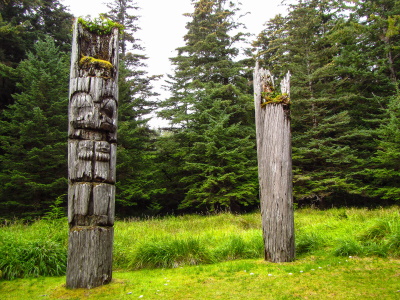SGang Gwaay

SG̱ang Gwaay holds the remains of traditional cedar longhouses and carved poles of the Haida.
This former village on the eastern side of Anthony Island was inhabited until the late 19th century. It still has a place in the traditions of the Haida culture. It has the largest collection of Haida totem poles in their original locations, many celebrated as great works of art.
Community Perspective: this is a remote place at the far southern end of the Gwaii Haanas National Park Reserve. Jay recently delivered a full report on the experience of visiting (“the poles are still standing … but the fine details on the poles continue to fade"), including the practicalities of getting there.



Map of SGang Gwaay
Community Reviews
Mihai Dascalu

We visited on July 25, 2023. Following the information shared by Jay T. (thank you so much). We took a four day tour with Moresby Explorers and reached SG̱ang Gwaay in the afternoon of the second day. We were lucky to have a watchman present at the site, he even sang to us a couple songs on a traditional drum. He made good jokes but he was also defensive and sometimes aggressive (and he admitted to it). He contradicted himself sometimes and admitted that he didn't know much of how things worked in the Haida society (because nobody really knows to this day).
The only thing that I can add to what Jay T said above is that our guide mentioned that Moresby Explorers is trying this year a two day trip to SG̱ang Gwaay. Considering the distance it would be a major undertaking in a zodiac especially if the weather is anything less than good. But probably the cost would be more accessible. For the two of us flights return Vancouver to Sandspit, two nights in B&B, before and after the tour, plus the four day tour came close to 7000 Canadian dollars and it took 6 days.
The picture shows the only house that you can "visit" there.
Zoë Sheng
Chinese-Canadian - 08-Sep-23 -

To be clear, SGang Gwaay is ONLY the site on what used to be called Anthony Island and getting here takes either your own yacht/boat or do a tour. The tours will visit a lot in Gawaii Haanas (another tentative site on its own that expands a LOT) and try to include the world heritage site although you aren't guaranteed if they are busy. My low review score, which you will have seen right way and I'm sure you are wondering why, is because this is a very small site of the Hadai nation and it should be extensive. In fact I didn't even like the poles so much and the remains of houses on SGang Gwaay and I found other sites like Tanu more rewarding to visit. To make it clear: this site is for cultural parts on the island, NOT the wonderful park. I'd definitely give Gwaii Haanas a five star rating when it is inscribed because the cedar forests, primal and untouched territories are a dream come true for someone like me. In retrospective the visit was one of the low-lights of the 4-day tour.
So for this review I'll stick to ONLY the site in the zone. Your tour operator (I also went with Moresby Explorers by the way, clearly a good choice!) will contact the Watchman on the site to arrange a time. If they are busy then you have to wait. Only ~15 people are allowed on the site per visit. The Haida a very strict on these and I cannot complain. You will first walk through the lovely forest and then meet the Watchman who will introduce the site before you head on. The site is very small. There are not many remains left and the house remains were already seen at other non-inscribed places. The main attraction in my opinion are the poles standing along the side of the island. The each have a story to tell, some are still identifiable very well and some are still known to the Watchman but was like looking at stalactite rock formations that the guide would say are a "couple hugging" and you just agree to move on. You will look at those for a good 15 minutes before you look at them from the back where the large house used to stand. The tour will end at the final pole before heading back to the restrooms.
The entire visit takes maybe 30 minutes which is less time that it goes the tour to anchor, walk over, toilet break, another toilet break after the tour and then walk back! When I got here I figured "oh there's another WHS yay" but in reality I wanted to go back to the forest and enjoy the walks some more. Luckily a tour through Gawaii Haanas gives a lot of opportunities. Overall I didn't find the site special and if it's combined with everything around the park including the natural aspect it would be a godly WHS. As a Canadian I want to respect the heritage and previously their poles were taken away and the Haida don't want them back ("they lost their soul"). Getting a glimpse of the sites is a good experience even if you only went to a regular Watchman site (maybe not the hotspring one haha). I also want to say the Watchman was doing a great job to explain everything and even played a song for the group before we departed.
I also ran into a park ranger at the lodge area and briefly discussed the site. There are no markings, "Haida don't like markings" she said, so there is also no UNESCO plaque. I could be at the heritage center back at Skidegate but I didn't check. She wasn't aware of much about extending the site. In the end they just let the Haida handle their sites and ensure the park is healthy (deer are a problem and they are all over the place), currently they were fixing up the boardwalk so I guess they came to supervise it.
Jay T

The poles are still standing. It has been over fifteen years since the last review of SG̱ang Gwaay, but the remarkably carved memorial and mortuary poles that led to this site being inscribed on the World Heritage Site are still in place. Weathering and decay are taking their natural toll on the village, as the fine details on the poles continue to fade. As far as the Haida people who populate the islands of Haida Gwaii are concerned, however, this is an expected part of life and should not be prevented.
Haida art became particularly well known worldwide through the craftsmanship of Haida artist and conservationist Bill Reid, whose lineage traces to the village of T'aanuu in Haida Gwaii. Bill salvaged many poles from villages throughout the islands and introduced Haida art to a global audience. His work has been featured on the Canadian 20 dollar bill, and one of his most famous sculptures, The Spirit of Haida Gwaii, sits in front of the Canadian Embassy in Washington, DC. When the World Heritage Site committee inscribed SG̱ang Gwaay on the World Heritage Site list in 1981, the choice of this village to represent Haida culture was in no small part due to the intricate carvings on the poles that so well represented Haida heritage and craftsmanship.
So what can be seen at SG̱ang Gwaay as of late summer 2022? Several mortuary and memorial poles still line the beach in front of the village. Mortuary poles were sets of poles erected to hold up a box with the remains of important persons from the village, while memorial poles were carved to honor specific people or important events. Carvings such as thunderbirds, bears, and whales can still be fairly easily identified on the poles. Interestingly, other villages I visited in Gwaii Haanas National Park Reserve and Haida Heritage Site did not have poles with such elaborate carvings, suggesting that SG̱ang Gwaay at one time had some skilled craftsmen in the village.
Also of note at SG̱ang Gwaay is a fairly large house pit, which is all that remains of one of the houses in the village. We were told by the Haida Watchmen at a separate village that the bases of Haida houses were dug in a day and the floors were laid down with cedar planks before nightfall so as to keep spirits from moving in and causing restless nights. The house would be constructed above the pit, with a large frontal pole anchoring the front wall, and additional poles holding up the beams of the one story house. The frontal pole would be carved with the family crests, and a doorway was cut into the bottom of the pole for guests to enter. In the center of the pit inside the house was a fire that would be used for cooking and warmth. The depth of the pit varied according to the importance of the family, so that there were some houses with stepped levels. At the large house pit that we observed at SG̱ang Gwaay, the beams of the house and the pit were still visible, though the wood continued to decay. The frontal pole was no longer present; many frontal poles from houses across Haida Gwaii were sent away to museums.
SG̱ang Gwaay was set in a small harbor with an island protecting the beach. The inhabitants of the village would have been able to fish and forage easily from their village. Unfortunately, although the Haida initially profited from contact and trade with the outside world, with contact came troubles, and in the 1860s a smallpox epidemic swept through Haida Gwaii, reducing the population of SG̱ang Gwaay so drastically that the remaining villagers moved to the community of Skidegate further north by 1878. The village was left in a state of decay that has continued to the present.
So what happens when all the wood has decayed in SG̱ang Gwaay, and all that is left are the house pits? I daresay it will be similar to other World Heritage Sites I've seen such as Birka or Cahokia Mounds, where some imagination will be necessary to comprehend what the village would have looked like. Thankfully, the Haida people have established a Watchman program, which places Haida volunteers at select villages in the islands to act as interpreters for the controlled visits to the sites. (Unfortunately the Watchman at SG̱ang Gwaay was out sick when I visited, but the guide on my tour was also well trained to interpret the site) Some people I talked with speculated about the value of a recreated Haida village in Gwaii Haanas, similar to the reconstructions of the longhouses at L'anse Aux Meadows, in order to give a better perspective of what the sites looked like. That could help, but that would have to be a decision for the Haida people to make, and as long as they maintain Watchmen, it may not be necessary. There is also a proposal for an extension of SG̱ang Gwaay to include the entire Gwaii Haanas National Park Reserve and Haida Heritage Site (with other unique villages), but that is a topic for a separate review. SG̱ang Gwaay in its present form will not last forever (nor should it), so I recommend visiting within the next decade or two before even more of the carvings fade away.
Logistics: SG̱ang Gwaay is at the far southern end of the Gwaii Haanas National Park Reserve and Haida Heritage Site, and can only be reached via established tour operators operating small tours in Haida Gwaii. Unfortunately, due to Covid, some tour operators are no longer working. I chose a 4-day tour with Moresby Explorers, an excellent company offering a Zodiac boat tour to different sites within Gwaii Haanas. For those with kayak experience, there are also guided kayak tours. The two main ways to get to Haida Gwaii are by plane to Sandspit on Moresby Island or to Masset on Graham Island, or by ferry from Prince Rupert to Skidegate on Graham Island. There is a regular daily ferry between Skidegate on Graham Island and Allisford Bay (near Sandspit) on Moresby Island. I didn't make it to Graham Island, but the Haida Heritage Center in Skidegate was highly recommended by fellow members of my tour group.
Read more from Jay T here.
Trevor
I recently went on a kayaking trip to SGaang Gwaii and found it to be an fascinating place. The old totem poles and long house were great to see as they will not be there much longer.The Hiada people believe they came from the earth and that they should return to the earth. They are located on the southern part of the Queen Charlotte Islands. I found a travel company on the internet located in the Charlottes. About the only way to get down to SGaang Qwaii is to use one of these companies as the last road is 100 miles to the north. We also stopped at Skedans an equally impressive site and should not be missed. I highly recommend going you will not be disappointed. Don't forget to ask about the hot springs.
Community Rating
Site Info
- Full Name
- SGang Gwaay
- Unesco ID
- 157
- Country
- Canada
- Inscribed
- 1981
- Type
- Cultural
- Criteria
-
3
- Categories
- Archaeological site - Pre-Columbian
- Link
- By ID
Site History
2006 Name change
From "SGaang Gwaii (Anthony Island)" to "SGang Gwaay"
2000 Name change
From "Anthony Island" to "SGaang Gwaii (Anthony Island)"
1981 Inscribed
Site Links
Unesco Website
Official Website
Related
In the News
Connections
The site has 19 connections
Art and Architecture
Geography
Human Activity
Timeline
Trivia
Visiting conditions
WHS Names
WHS on Other Lists
World Heritage Process
Visitors
10 Community Members have visited.